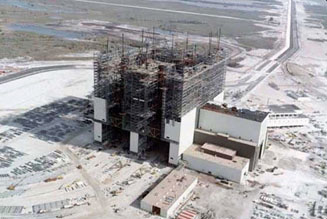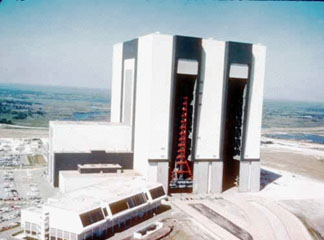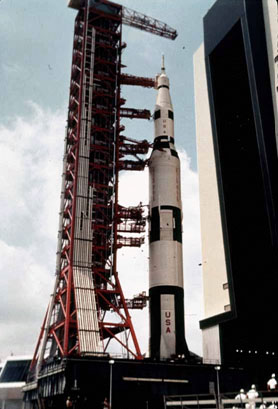Soon after the advent of the Apollo space program in 1961, the newly formed National Aeronautics and Space Administration (NASA) approached the U.S. Army Corps of Engineers for design and construction assistance. One of the Corps most challenging assignments was the construction of the vehicle assembly building (VAB) at the John F. Kennedy Space Center (KSC) on the east coast of Florida. Responsibility for the project initially was given to the Jacksonville District and then, in 1963, was passed on to the newly established Canaveral District.
 |
|
 |
| The VAB under construction. For perspective, the so-called low bay on the right side of the VAB was 210 feet tall. |
|
VAB with the launch control center in the foreground. Note that the bottom portion of the VAB doors are partially open. |
Built for the Apollo program, the VAB was the hub of launch operations at the space center. Designed to house the assembly and final checkout of the 363-foot-tall Saturn V launch vehicle, the vehicle assembly building enabled engineers to assemble the rocket in a protected, climate-controlled environment. At the time of its construction the VAB was the largest building in the world enclosing 128 million cubic feet of space, three times the volume of the Empire State Building.
|
Rising to a height of 525 feet above the surrounding wetlands, the VAB covers almost eight acres. The mammoth structure rests on 4,200 steel piles, each driven to bedrock 160 feet below the surface. Construction of the VAB, which began in 1962 and was completed four years later, required 58,000 tons of steel and more than one million rivets. The building cost approximately $100 million to complete. In 1966 the American Society of Civil Engineers named Launch Complex 39, of which the VAB was an integral part, as the outstanding civil engineering project of the year.
One of the VABs most notable features is its 456-foot-high doors. Designed to accommodate a fully assembled Saturn V, the T-shaped doors are 152 feet wide at the base and taper to 76 feet wide at the top.
Between 1966 and 1975 the VAB housed Saturn launch vehicles. In 1980 the building acquired a new tenant, the Space Shuttle. Today, more than three decades after it was completed, the VAB still serves as the final assembly point for the shuttle orbiter, external fuel tank, and twin solid-rocket boosters prior to the regularly scheduled shuttle launches.
Read more about the History of Canaveral District.
|
 |
| |
Positioned on its mobile launcher, a fully assembled Saturn V launch vehicle leaves the VAB. |
* * *
May 2002